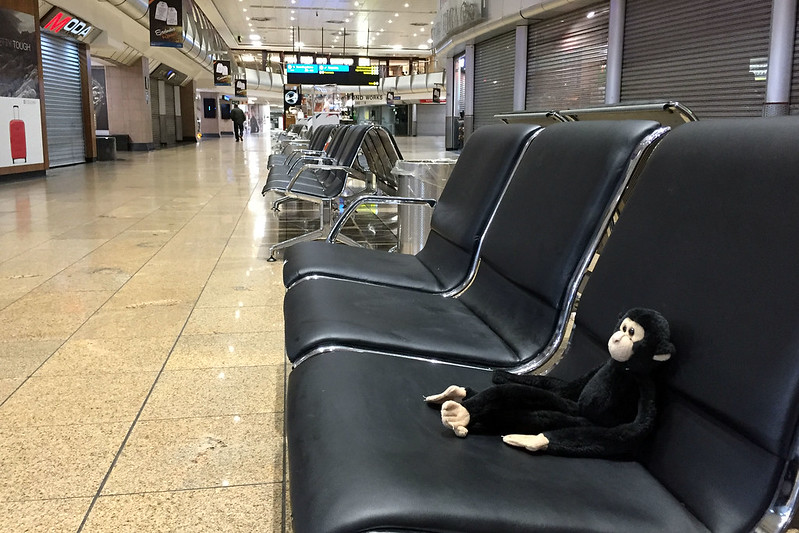
Killing time in Johannesburg Airport
[ <<previous | index | next >> ]
01:11. Johannesburg Airport
We have just boarded our connecting flight to Nairobi. It was supposed to depart at 00:55, so this one is running a bit late too. Hopefully we'll have enough time to make our next connection from Nairobi to Kilimanjaro International Airport. We are supposed to have about an hour and a half to make the connection, but it will probably end up around an hour or maybe less.
This plane is a Boeing 737, which is quite a bit smaller than most planes I fly on, so it feels pretty squishy. There's also some confusion over which row we're sitting in. It's highly ambiguous which row of seats the "row 25" label is over, and we dithered until another passenger confidently asserted that the one further back was 25. But now there are passengers in front of us who are supposed to be in the seats across the aisle, occupied by people with seats in row 24, but the seats in front of them are vacant, so maybe we're all a row further back than we should be. It looks like only a few more people to board, so we'll see what happens.
Inside the airport, we stayed in the Shangololo lounge until it closed at 22:00, then were forced to wander the terminal. By now most of the shops had closed, but there were a handful still open. We looked at some of the African art and housewares for a bit, but were tired so found a seat not too far from our gate to relax a bit more.
 Killing time in Johannesburg Airport |
The time meandered by slowly, until I remembered that I still had a Lindt ball from the Qantas flight in my top jacket pocket. But as I reached in to pull it out, I found a soft, mushy mess. The chocolate had melted and leaked out of the wrapping, into my pocket, creating a large oily stain spreading through the fabric around the pocket. I raced to the toilets, removed the jacket, and washed the pocket out as thoroughly as I could with the bathroom soap and water, then tried to dry it as best I could using a hot air hand dryer. The dark brown chocolate came out pretty well, but it remains to be seen how visible the oily stain is when the material dried properly.
That drama dealt with, we wandered over to the gate where there were occupied seats and a few people standing around waiting. We stood near the sliding glass door that led to a ramp heading down to the jet tube. Staff kept wandering back and forth, in and out of the door, but not letting anyone through until almost 01:00. Then they let two men who looked like passengers in and closed the door again, as another slightly angry man protested that he was business class and why couldn't he go in as well? M. guessed the first two guys were some sort of VIPs, but it was a mystery to us.
A few minutes later they called for business class passengers and let them through after inspecting boarding passes, and then rows 20 to 35, which included us. It's now 01:28 and we still haven't left the gate, but it looks like it should be soon, so hopefully we won't be more than half an hour late into Nairobi.
12:27. Four Points by Sheraton hotel, Arusha
Well, we made it. As it turned out, we were indeed half an hour late landing in Nairobi, at around 06:30. Our connecting flight was scheduled to depart at 07:35. So what should have been a 90 minute connection was cut to an hour. But that wasn't all.
The taxi at Nairobi was pretty long. And it didn't end at a jet tube; the plane parked on the tarmac and we had to disembark down stairs and climb into a bus. The bus was about half full as we got in, and we moved to the centre to let more people on. Unfortunately this was a bad move, because when the bus finally got to the terminal - after stopping for several minutes halfway there for no apparent reason - we were the last people off the bus. Then everyone had to go upstairs to the transit and immigration areas. There were stairs or an escalator. M. chose the escalator and we joined the queue of people. As we approached the escalator, the woman in front of us was manoeuvring with a young girl who had trouble getting on the escalator. The girl tried several times, tripping and falling and then being afraid to step onto the moving steps. We ended up having to wait there for several minutes and we couldn't go back and use the steps because there was someone else waiting right behind us. By now everyone else from the plane had reached the top of the steps and vanished, while we were still stuck at the bottom waiting for this girl to get on the escalator. Finally she managed to step on and we got on behind. But at the top as the girl tried to step off she fell and blocked the way, with us coming up behind with no way to stop. So we ended up in a big collision of bodies and luggage.
All this had consumed several valuable minutes, and by now we only had 30 minutes to the departure of our flight to Kilimanjaro Airport. We walked quickly along corridors and ended up at a security checkpoint before being allowed into the terminal. And the queues there looked pretty long. I told a security guy that we had a connecting flight leaving in 30 minutes, but he merely waved us to the back of the queue. While waiting to go through, I spotted a departure board, which listed our flight and said that it was leaving from gate 24. I looked around and saw that gate 22 was the closest gate on one side, with 21 further away, so I assumed 24 was nearby on the other side and that we would have enough time to catch our flight. We made it through security and looked for gate 24, only to discover that it wasn't nearby, it was down a long corridor and then downstairs and down another corridor. We got there and saw the sign at the gate saying "final call" for boarding! So we quickly showed our boarding passes and went through... to get on a bus to take us out to the plane on the tarmac. There were only a few people on the bus, and we commented to a family there that our connecting flight had only just arrived. But as we waited, several more people came through behind us and got on the bus, including some I recognised from our previous flight. So maybe it wasn't as fraught as we thought.
The bus took us to an Embraer 190 jet, which is a small jet seating under 100 people. On the way out to it, we passed right by the plane we'd just got off - if only we could have simply walked from one plane over to the other! Fortunately this time we were one of the first off the bus and so nearly first onto the plane from this busload (there were already about half the passengers on board, presumably from a previous bus). We stowed our bags, happy to get away with carry on bags on each leg without being forced to check any bags. The overhead storage space was limited and a few other passengers ended up having to check bags that they'd carried on.
The flight was very short, only 35 minutes or so in the air, plus taxi time. We were given a bag of mixed nuts that was just cashews and macadamias, so very nice. And the plane had begun to descend already before we got our cup of water. During the flight we got a fairly close view of Mount Kilimanjaro, rising impressively through the cloud cover below, with snow on the peak. We also saw Mount Meru, which is impressive enough in its own right.
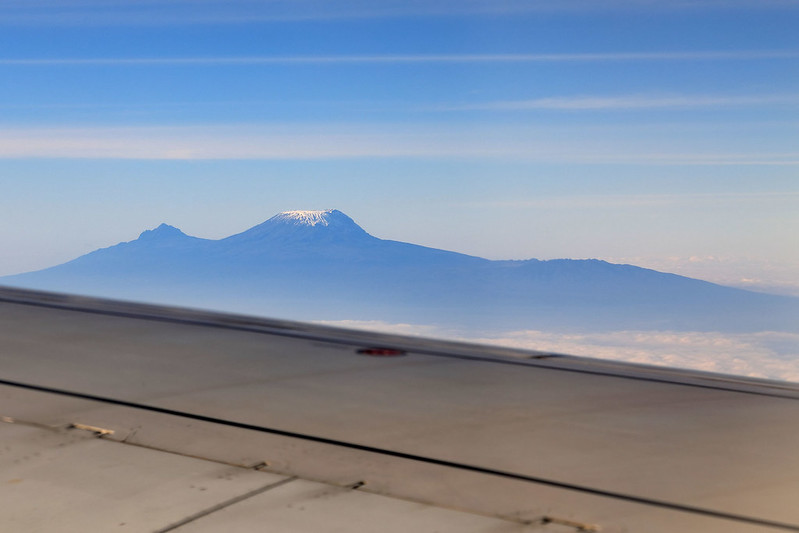 Mount Kilimanjaro, from Nairobi-Kilimanjaro flight |
We landed at Kilimanjaro International Airport, which is a single runway with no adjacent taxiway, and a small terminal where you get off the plane and simply walk across the tarmac into the building. We stopped first outside the building where women in rubber gloves inspected our yellow fever vaccination certificates, then let us pass to another set of ladies who inspected our boarding passes, before letting us walk into the building where immigration officials were waiting to check visas and stamp our passports. Then we had to pass our bags through an x-ray machine, and finally we could exit.
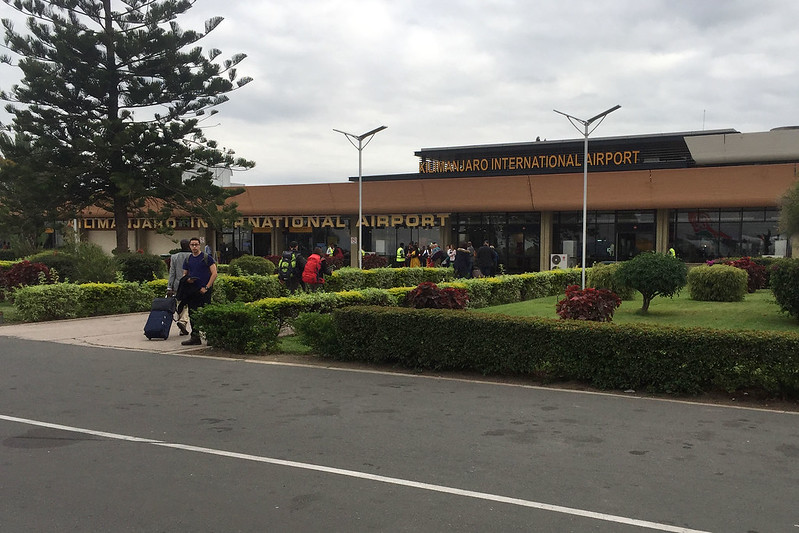 Kilimanjaro International Airport |
As we came out of the customs area we were met by our guide, holding a sign with our names on it. He greeted us by first names, then introduced himself, saying his name was Elisha, but that he usually goes by Timba. He escorted us to a large Toyota Land Cruiser, kitted out for safari travel, with eight seats and openable roof hatches. He said the road to Arusha was paved and very good, but later in the tour we would be going off road, and getting what is called the "African massage" by the bumpy terrain. We asked if he was simply taking us to our hotel or if he'd be our guide for our whole tour. He indicated the latter, which is nice as he seems very friendly.
The drive to Arusha and our hotel took about an hour. Along the road on either side were mostly sunflower and corn farms. Timba said they used corn to make the staple of boiled cornflour, called ugali. The road itself was a fairly narrow two lane affair, and we got stuck behind slow trucks a few times until it was safe to pass them. We passed through the tiny town of Kikatiti. Then the larger towns of Maji ya Chai, Usa River, Kilaka, and finally Tengeru, where it was market day. Hundreds of people were converging on the marketplace a block or so off the road and only partly visible from our viewpoint in the car. I took a couple of photos of the activity after asking Timba if it would be okay, as I didn't want to be rude about taking photos of people.
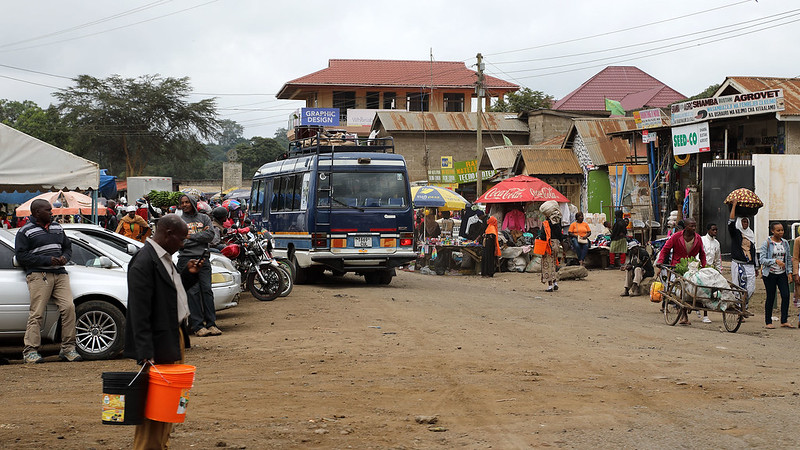 Market day in Tengeru |
After a while the road divided and had two lanes each way, the traffic picked up, and I knew we were entering Arusha. Timba said it is the fourth largest city in Tanzania, with a population of about a million people. The outskirts look very rustic with old rural style construction mixed with banana trees and other vegetation, but near the centre of town appeared modern buildings of ten or so storeys: hotels, hospitals, office buildings, etc.
We arrived at the Four Points by Sheraton, a fancy resort style hotel right in the centre of town, on the clock tower roundabout. Timba told us that the clock tower marked a spot halfway between Cairo and Cape Town, making it the centre of Africa. This story must be well know to all the locals, because we heard it at least three more times from different people later in the day.
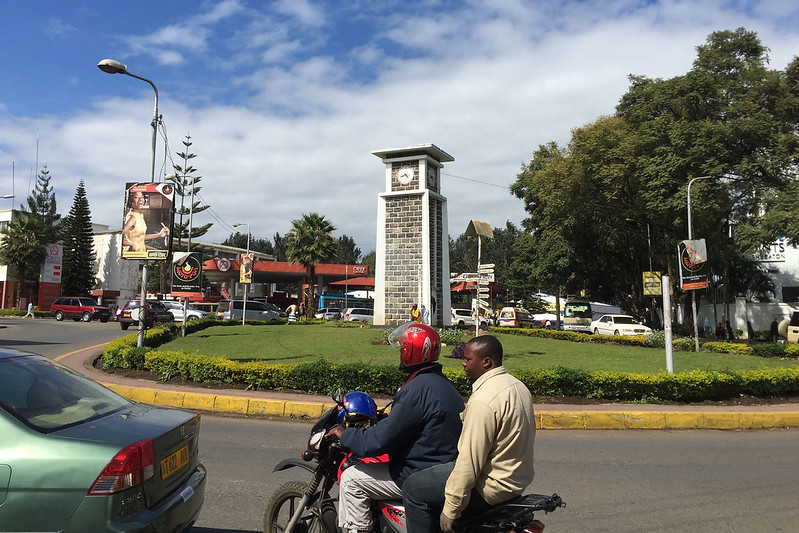 The Arusha clock tower |
The driveway into the hotel was guarded by a boom gate and a bunch of security guards, who inspected underneath the car with a mirror before letting it through. Once through that, we pulled up at the front door of the hotel, where there was a metal detector that we had to walk through and an x-ray machine for our bags. We've never seen such security at a hotel before!
Timba took us in to check in, then introduced us to Naoma and Greylove, a woman and man who worked for Sense of Africa, the tour company we are booked with. We'd told Timba that we were hungry and wanted breakfast first before talking to the company representative about our tour, but Noama led us to a table and proceeded to go through the tour details with us, only checking with the hotel staff that the buffet was still open for breakfast so that we could get some afterwards. Fortunately she didn't take too long, and then we eagerly grabbed a table and explored the buffet.
Nobody else was eating breakfast, as it was well after 10:00 by now, and it seemed we had the leftover bits of the buffet that had been sitting there a while. I grabbed some French toast, beef sausages, and some sort of African vegetable dish that may have been the boiled corn thing Timba mentioned, mixed with other vegetables and spices. While I grabbed these, a woman emerged from the kitchen and asked if I'd like some fried eggs or an omelette. Once I figured out that she was going to make them to order, I asked for an omelette with mushrooms and chillis. She also put cheese in accidentally, but that was fine. M. had some French toast, some mini croissants, and fresh pineapple, which I also grabbed quickly as a second helping before they removed the buffet, which they started doing while we were still eating.
After this hearty breakfast, we finally went up to our room. I had a shower while M. wrestled with the hotel WiFi, eventually phoning the desk and having them bring up temporary passwords on slips of paper while they sorted out our name as the password for the room number.
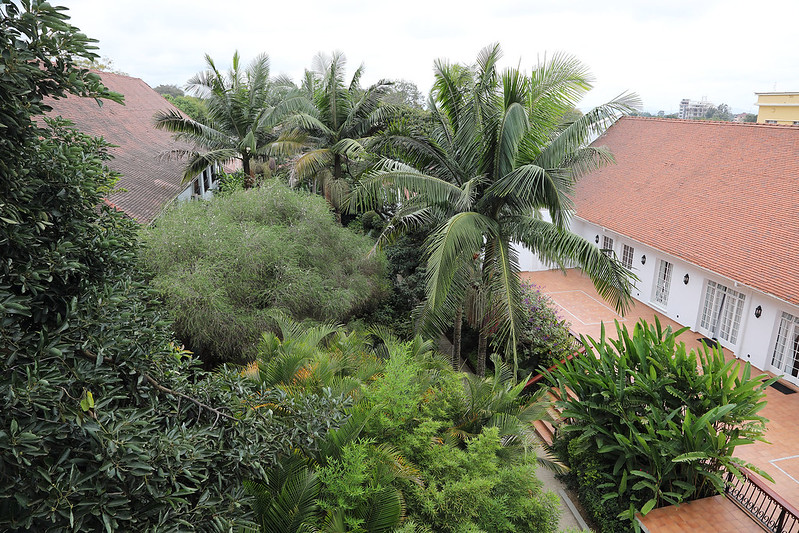 View from our room at Four Points by Sheraton, Arusha |
20:56
We'd arranged, or so we thought, to meet Greylove at 14:00, to accompany us out and about the centre of Arusha for the afternoon. This was after some rather strong advice from Naoma that we didn't really want to go out alone, because we'd constantly be harassed by people trying to sell us something. Although we could easily walk to the places we wanted to go, doing so would be running a gauntlet of touts and would be much easier with a local guide, as they could tell people off and protect us with their aura of native savvy.
So we went down to the hotel lobby just before 14:00 to wait for him. After 15 minutes of no show, M. went to the hotel desk and told them we were waiting for him and if they knew what was happening. They said something about people waiting outside around the corner for us and he walked out to talk to them. Then he came back in and nothing happened for another fifteen minutes. So we tried again, this time M. explaining what we expected a bit more carefully. A desk guy went out and retrieved what we think was a member of the hotel staff, one of the drivers, to take us out into the town. We weren't quite sure what was going on, but left with him, telling him we wanted to walk to stretch our legs, not be driven around.
First he led us to a nearby ATM where I got out some local currency, Tanzanian shillings. Then he took us the short walk a few blocks to The Tanzanite Experience, passing the clock tower and telling us the story about that again. The Tanzanite Experience is a combination informative presentation/marketing spiel/shop, all about the unique blue gemstone, which is only found in one place in the world, about 50 kilometres out of Arusha in the foothills of Kilimanjaro.
We arrived at the same time as a group of about a dozen young women tourists, and filed in for a 15 minute video which explained the history of the gemstone, a brief overview of mining, grading, and cutting, and then several minutes of telling us how unique and valuable they are and that we must have one. Then a lady led us through a tour of a simulated tanzanite mine, showing us what the mineral veins look like, how they are extracted, and what other minerals occur near tanzanite deposits. This included samples of actual rock which she passed around: quartz, calcite, pyrite, graphite, and possibly another one. Then we went into another room where she explained grading and cutting the gems. It turns out that the original deposits found near the surface are naturally the desirable deep blue colour, but stones found underground are paler or even brown in colour. They are turned blue by exposure to higher temperatures, which over millions of years turned the ones near the surface blue, but which can be accelerated in duller stones by heating to around 450°C for a few hours.
She then led us to the display area where hundreds of gems were for sale, mostly as unset stones, but some set in rings, earrings, necklaces, and so on. The largest ones were the deepest blue, and of course the most expensive. M. looked at a smaller one within a more reasonable price range, but the colour was less intense, and the lady explained that the intensity came through the size and depth of the stone, so smaller ones can never be as rich in colour. M. was considering buying one, but the staff were busy serving the other women and we had our guide waiting patiently for us, so we decided to move on.
We wanted him to take us to the local market, where residents trade and buy food items. This is supposed to be very colourful and interesting, but also a slightly dangerous place for tourists due to pickpockets and other nasties plus general harassment. However, he received a phone call from the hotel and said he had to go pick up someone from the airport, so he could walk us to the market but then had to leave right away. This didn't sound appealing to us, so we returned with him to the hotel.
We sat and M. had a cappuccino from the small cafe near the front entrance. It was large and came with a full size choc chip cookie. M. said the coffee was very good. We decided we still wanted to go out some more, as it was about 15:30 and we didn't want to just sit around and get sleepy. So M. asked if the front desk could contact Naoma at Sense of Africa, to have someone sent over to guide us around. She'd told us earlier that she could do this if we wanted an escort in the town. They phoned up and eventually got in touch and told us that someone would be coming over to meet us soon.
A while later, Naoma and Greylove both arrived with a Land Cruiser. They said they needed to change cars for some reason and another car would be arriving soon. When it appeared, a guy got out and they swapped cars, and the guy put spare tyre covers with a different company's logo over the top of the Sense of Africa ones on the first car. So maybe the companies just swapped cars? Anyway, we got into the other Land Cruiser, which seemed almost identical to the first, and Greylove drove off with us plus Naoma in the front.
We said we wanted to go to the Maasai Market, an arts and crafts market. However we drove a few kilometres, when we knew the market was just a short walk away. The drive really highlighted the differences between a first world city and an African one. The road was narrow and potholed and lined with dusty areas where people were walking, riding bicycles, pulling carts, or just sitting and chatting. Run down buildings opened onto the dusty sidewalks, with tiny shops, and workshops with men doing woodwork or welding or fixing motorcycles or whatever. Goats and chickens wandered around freely. In places there was a deep gutter with running water in the bottom; I don't know if these were open sewers or what. And people everywhere, going about their daily business. Men in jeans and T shirts, women in colourful African dress.
It turned out they were taking us to a Cultural Heritage Centre, which we hadn't known about, but which turned out to be pretty interesting. It was mostly just shops, filled with African artwork and craftwork in hundreds of styles: carvings, decorative arts, paintings, fabrics, clothing, masks, drums, and so on. There was also a small tanzanite shop where we looked briefly. I found some cool African print shirts, and bought one for myself. Adjacent to all of this was a large building in a modern architectural style with sweeping curves reminiscent of African drums, which a shopkeeper told us was the largest art gallery in Africa and we should have a look. But we didn't have time as we wanted to check out the Maasai Market still.
So we headed back to the car and Greylove drove us there. This market was very different, with tiny stalls in cramped rows inside a run down garage-type building, plus stalls spilling out into the dusty courtyard in front, with people hawking wares from blankets. It was noisy and boisterous, and we realised how sedate the cultural centre was in comparison. When we arrived, I also saw the women from the Tanzanite Experience there.
 Maasai Market, Arusha |
As we walked down the rows of stalls, the keeper of each one would beg us to give them just "one minute" and come in to look at their stuff. There was a mixture of carvings, paintings on canvas, beadwork, fabrics and clothing, and a few other things. It was pretty full on. M. later told me that Greylove had been following us at a discreet distance, probably to keep an eye out and rescue us if we got into any trouble. M. bought three small beadwork bracelets from a group of women out the front, soliciting Greylove's help to determine and bargain down to a fair price. The sun was sinking lower as we explored the market, and they day was turning to dusk by the time we left.
We drove back to the hotel as it was now after 18:00, and we wanted to eat dinner when the hotel restaurant opened at 19:00 so we could get an early night to catch up on sleep. At 19:00 we went down from our room to the restaurant, where we got a table next to a pillar, near an open door where a cool night breeze was blowing in from the verandah. Several people were sitting outside dining on the verandah, but it was a bit chilly for us.
The restaurant had a mix of western and African food, plus a large selection of Indian food. Perusing the menu, M. ordered a dhal tadka with rice and a roti. I tried an African dish, kuku mchicha, which was chicken cooked with African spinach (mchicha), served with coconut rice. I also ordered a paratha to go with it, which was an interesting variation with mint. M. had a glass of South African red wine, while I chose the "Hatari sunset", a cocktail made with Tanzanian gin, coconut infused rum, orange juice, and grenadine. The food was very nice, and the chicken and mchicha had an interesting flavour which was maybe a hint of cumin with something else I couldn't identify. The serving was generous too, and we were very full by the end.
 Kuku mchicha and rice |
We retired to our room where M. elected to simply climb straight into bed and have a shower in the morning. It was 20:30. I stayed up typing this until 21:00, then crashed to sleep myself.
[ <<previous | index | next >> ]